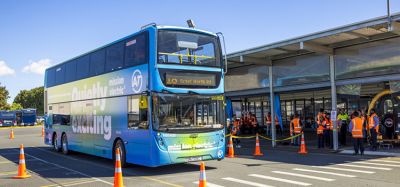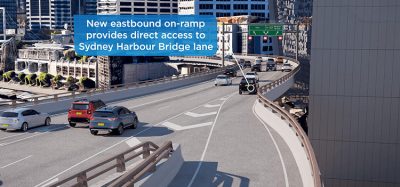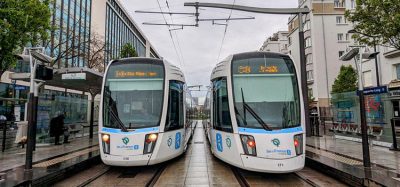Improving security on urban transport systems
- Like
- Digg
- Del
- Tumblr
- VKontakte
- Buffer
- Love This
- Odnoklassniki
- Meneame
- Blogger
- Amazon
- Yahoo Mail
- Gmail
- AOL
- Newsvine
- HackerNews
- Evernote
- MySpace
- Mail.ru
- Viadeo
- Line
- Comments
- Yummly
- SMS
- Viber
- Telegram
- Subscribe
- Skype
- Facebook Messenger
- Kakao
- LiveJournal
- Yammer
- Edgar
- Fintel
- Mix
- Instapaper
- Copy Link
Posted: 24 June 2005 | James Abbott, Technical Editor | No comments yet
Video cameras, platform access gates, plastic film on glass to prevent etching – these are just some of the ideas being used by public transport authorities to frustrate criminals and vandals.
Security is a big issue for public transport authorities. Not only are they concerned about keeping their own property safe from criminals, they also wish to keep a safe system to reassure passengers. “Statistics show that 73% of men and 89% of women are worried, or at least feel uncomfortable, about having to travel by bus or train late at night” says Verint RP, a US/German firm which manufactures video processing technology and fleet video management software. “The word ‘having’ distinctly stresses the lack of confidence in public transport for bringing passengers to their destinations safely and enjoyably.”
Video cameras, platform access gates, plastic film on glass to prevent etching – these are just some of the ideas being used by public transport authorities to frustrate criminals and vandals. Security is a big issue for public transport authorities. Not only are they concerned about keeping their own property safe from criminals, they also wish to keep a safe system to reassure passengers. “Statistics show that 73% of men and 89% of women are worried, or at least feel uncomfortable, about having to travel by bus or train late at night” says Verint RP, a US/German firm which manufactures video processing technology and fleet video management software. “The word ‘having’ distinctly stresses the lack of confidence in public transport for bringing passengers to their destinations safely and enjoyably.”
Video cameras, platform access gates, plastic film on glass to prevent etching – these are just some of the ideas being used by public transport authorities to frustrate criminals and vandals.
Security is a big issue for public transport authorities. Not only are they concerned about keeping their own property safe from criminals, they also wish to keep a safe system to reassure passengers. “Statistics show that 73% of men and 89% of women are worried, or at least feel uncomfortable, about having to travel by bus or train late at night” says Verint RP, a US/German firm which manufactures video processing technology and fleet video management software. “The word ‘having’ distinctly stresses the lack of confidence in public transport for bringing passengers to their destinations safely and enjoyably.”
The same story came from research carried out last year by the security firm Group 4 Securicor concerning perceptions of security on the London Underground and national rail network in Britain. One in every five British adults admitted to being more afraid to travel on trains or the Underground, compared with 12 months before. Of these people, 38% attributed their feelings to fear of personal assault. Fear of intimidation accounted for a further 14%, alongside inebriated or lewd passengers, which was cited by 11% of people asked. In the wake of the 9/11 attacks and the Madrid train bombings the international situation has also become more relevant: over a third (36%) of those who were more afraid to travel attributed this fear to the increased threat of terrorism.
In the face of this increase in concern, a multi-layered approach is being taken to security. First, operators seek to keep anti-social elements off the railway if they have no business there. Second, the physical surroundings on public transport systems are being designed and specified in a way which will help prevent attacks on people and things – an example would be transparent waiting shelters. And third, behaviour of people on public transport systems is monitored wherever possible.
Keeping criminals out
While the primary purpose of ticket gates is to eliminate fraudulent (ticketless) travel, an important side benefit of a gated system is that it keeps people who have no business on a railway platform off the system. Bored groups of youths will sometimes wander onto platforms and make trouble – but if they have no tickets, gates will keep them out. This has been cited as an important benefit of gates by many British rail companies; gates are now widespread in that country, with Cubic Transportation Systems the principal supplier.
Gates are also gaining in popularity on the continental mainland of Europe. Following a study carried out by the transport authority for the Rhône and Lyon area of France (SYTRAL) in 2001 on fraud in public transport in the Lyon area, the authority decided to replace the existing validators by automatic gates. SYTRAL awarded Automatic Systems (AS) of Belgium a contract for the implementation of access control equipment.
Since December 2004, the installation of automatic gates and interlocks, combined with magnetic ticket readers and tele-ticketing solutions, has been contributing to more efficient control of passengers on the Lyon metro. The first five stations to be equipped with the new system are Massena, Hôtel de Ville, Part-Dieu, Laurent Bonnevay Astroballe and Gare de Vaise; 36 additional stations will be upgraded progressively in 2005 and 2006.
Altogether, the Lyon contract comprises 641 TGH 800 automatic gates, 62 TGL 870 Interlocks, and 15 TGE 860 only-exit doors. This is the biggest contract ever won in the area of public transport by Automatic Systems.
Magnetic stripes and contactless card readers will be integrated in the automatic gates.
Automatic Systems is incorporating major innovations in the Lyon contract in terms of accessibility and user-friendliness, which will facilitate passengers’ flow into the gates while reinforcing the fight against fraud. For example, 600mm wide passages, designed to ensure better accessibility to persons with luggage, are being installed in those stations with direct connections with the French national railway network, such as Part Dieu and Perrache stations. Dynamic pictograms associated with lighting signals are located at the entrance doors in order to guide passengers into the gates and indicate where to present the ticket for validation. A new design of gates has been customised to meet SYTRAL requirements.
The battle against graffiti
Graffiti is a widespread problem. Harmless in itself, it can nevertheless engender a sense of fear in law-abiding passengers – and gives an impression that the railway is out of control. It was for this reason that a few years ago a decision was made to clean up the New York subway, which had been covered all over in paintcan scribblings. The project required relentless treatment of walls and trains – as soon as a scribble appeared, it was removed. The graffiti artists get a kick from seeing their ‘tags’ – instantly removing them frustrates that and prompts the vandals to find something else to do. The New York experience in creating a more welcoming travel environment has been held up as a model for others to follow. A number of anti-graffiti products are available, including varnishes which can withstand the attack involved in removing graffiti.
One form of graffiti that is particularly difficult to deal with is etched glass – where removal of tags is much more difficult than on other forms of building materials and where tags can persist for a long time. Windows on the Berlin S-Bahn, for instance, are badly obscured by etching.
Plastic films are now being made to protect the glass and these are being tried out by a number of metro operators. For instance Metronet, which is responsible for upgrading over half the London Underground system, is currently refurbishing trains on the District Line and does not want etched glass to ruin the impression of a ‘good-as-new’ train. Metronet is experimenting with plastic films from a number of suppliers, including Kent-based Chicago Glass.
Deterring vandals
The District Line refurbishment, currently being carried out at the Derby works of Bombardier, is an interesting case study as it incorporates a number of security advances. One idea is a simple one adopted by many metro authorities: windows are being cut in the end walls of the carriages, giving a clear view from one carriage to the next. Vandals left alone in one carriage will be deterred from using paint sprays and other devices that would damage the train if they can be seen from the next carriage.
Another simple idea is a redesigned armrest. Youths misbehaving in trains on the District Line have had a habit of walking up the train on the armrests: the new design makes balancing on the armrests more difficult.
Video cameras from Innovonics of Australia are being installed on the District Line trains. These will capture activity in the saloons to a standard that can be used in court if necessary.
The most recent on-train CCTV systems not only record events on the train, they also transmit them by wireless to a control centre for real-time monitoring. Such a system has been installed on the Copenhagen mini-metro, while on the Docklands Light Railway, Falcon Protec and Wavelength Solutions have a contract to install real-time anti-vandal CCTV on the trains by 2006.
These systems are following a growing trend to install video recording equipment in trains and buses. One company active in this field is Verint RP, which has had contracts to install video equipment in vehicles owned by authorities and companies as diverse as London General buses in the UK, Nancy in France and Hanauer Strassenbahn in Germany.
One recent big contract has been for DSB, Denmark’s state rail operator, which is deploying Verint’s Networked Video Solution to enhance passenger security on the Copenhagen railway system. DSB transports 700,000 passengers each working day across Copenhagen’s rail network. As part of an ongoing strategy to enhance passenger security and improve customer service, DSB is implementing Verint’s Mobile Networked Video Solution in carriages in certain portions of the Copenhagen railway system. The Verint solution will enable onboard rail operations personnel to monitor activities to help prevent crime and create a safe environment for passengers and employees.
Another supplier in this area is the French company Actia, which provides expertise in product design and validation, software development, manufacturing, final product assembly and tests for vehicle manufacturers. Actia was created in 1986, as a management buy-out from Renix. Renix was a joint venture between Renault and Bendix Electronics, created in 1978 to design and manufacture electronic control modules for the automotive market. Inside Renix, Actia was the special products department focused on commercial vehicle applications (truck, bus and off-highway vehicles).
CCTV monitoring stations
While increasing numbers of public transport authorities are making video recordings on their vehicles, closed circuit television monitoring is also increasing in popularity for the fixed parts of the system. One system of special interest is the Moscow Metro in Russia, where there are serious concerns about terrorist attacks.
Recently, the Moscow Metro made the decision to upgrade its existing non-coordinated analogue security system with the latest CellStack surveillance technology from Telindus Surveillance Solutions Ltd. Moscow Metro has over 200 kilometres of track used by approximately nine million people every day, creating the largest surveillance installation to date in Russia, covering 170 stations and ten control rooms.
Following the successful introduction of the video surveillance system, Moscow Metro now plans to use a similar Telindus Surveillance Solution-based system to drive video based passenger help points, (for bi-directional audio and video communications). By the end of 2005, 250 help points will be positioned on every platform of the five main lines, and controlled by operators in the main control room.
The system was built around 60 CellStack Centauri video hubs, (increasing to 81 by the end of 2005) a modular system consisting of a centralised control module responsible for all system activity and video encoder modules using M-JPEG compression format, which provide high quality video and fully configurable profiles over the ATM network.
The CellStack Centauri system allows Moscow Metro to integrate existing conventional CCTV equipment into an advanced Cisco digital network incorporating up to 1,000 cameras in the first phase alone. The next phase of the update was to install the CellStack Centinel networked video recorder (NVR) to allow the compressed video to be recorded directly from the network in M-JPEG compression formats. This enables an authorised security guard to then playback/review the recorded digital video on the same analogue monitors as live images.
Additionally, they can send any received real-time video stream over a wireless network to an authorised Real Time Streaming Protocol (RTSP) client, such as a handheld PC, allowing a roving security guard to view both live and stored video.
Related topics
Security & Crime, Vehicle & Passenger Safety
Issue
Issue 2 2005
Related people
James Abbott








